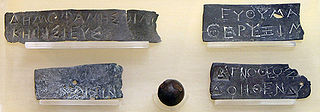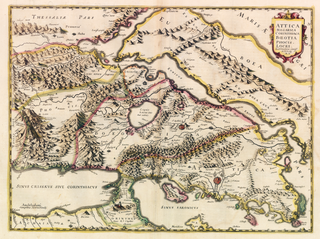Related Research Articles

Attica, or the Attic peninsula, is a historical region that encompasses the city of Athens, the capital of Greece and its countryside. It is a peninsula projecting into the Aegean Sea, bordering on Boeotia to the north and Megaris to the west. The southern tip of the peninsula, known as Laurion, was an important mining region.

In Ancient Greece, a deme or demos was a suburb or a subdivision of Athens and other city-states. Demes as simple subdivisions of land in the countryside seem to have existed in the 6th century BC and earlier, but did not acquire particular significance until the reforms of Cleisthenes in 508 BC. In those reforms, enrollment in the citizen-lists of a deme became the requirement for citizenship; prior to that time, citizenship had been based on membership in a phratry, or family group. At this same time, demes were established in the main city of Athens itself, where they had not previously existed; in all, at the end of Cleisthenes' reforms, Athens was divided into 139 demes to which one can be added Berenikidai, Apollonieis, and Antinoeis. The establishment of demes as the fundamental units of the state weakened the gene, or aristocratic family groups, that had dominated the phratries.

Cape Sounion is the promontory at the southernmost tip of the Attic peninsula, 8 kilometres (5.0 mi) south of the town of Lavrio, and 69.5 km southeast of Athens. It is part of Lavreotiki municipality, East Attica, Greece.
Decelea, Dekéleia), was a deme and ancient village in northern Attica serving as a trade route connecting Euboea with Athens, Greece. It was situated near the entrance of the eastern pass across Mount Parnes, which leads from the northeastern part of the Athenian plain to Oropus, and from thence both to Tanagra on the one hand, and to Delium and Chalcis on the other. It was situated about 120 stadia from Athens, and the same distance from the frontiers of Boeotia: it was visible from Athens, and from its heights also might be seen the ships entering the harbour of Peiraeeus.
Phyle is an ancient Greek term for tribe or clan. Members of the same phyle were known as symphyletai, literally: fellow tribesmen. They were usually ruled by a basileus. Some of them can be classified by their geographic location: the Geleontes, the Argadeis, the Hopletes, and the Agikoreis, in Ionia ; the Hylleans, the Pamphyles, the Dymanes, in the Dorian region.

The trittyes, singular trittys were part of the organizational structure the divided the population in ancient Attica, and is commonly thought to have been established by the reforms of Cleisthenes in 508 BC. The name trittys means "third", and is named such because there were three types of regions in each trittys. There were thirty trittyes and ten tribes named after local heroes in Attica. Trittyes were composed of one or more demes; demes were the basic unit of division in Attica, which were the smaller units of population that made up the trittyes..
Laches was an Athenian aristocrat and general during the Peloponnesian War.
David Malcolm Lewis was an English historian who was Professor of Ancient History at the University of Oxford. He is most renowned for his monumental two-volume edition of the inscriptions of Archaic and Classical Athens and Attica. His breadth and depth of knowledge was so widely admired that for decades he was invited by other scholars to comment upon and improve a high proportion of all book manuscripts in the field of Greek history before they went to publication.
The Greek-language inscriptions and epigraphy are a major source for understanding of the society, language and history of ancient Greece and other Greek-speaking or Greek-controlled areas. Greek inscriptions may occur on stone slabs, pottery ostraca, ornaments, and range from simple names to full texts.
Josiah Ober is an American historian of ancient Greece and classical political theorist. He is Tsakopoulos-Kounalakis Professor in honor of Constantine Mitsotakis, and professor of classics and political science, at Stanford University. His teaching and research links ancient Greek history and philosophy with modern political theory and practice.
Antiochis was one of the ten tribes (phylai) into which the Ancient Athenians were divided.
Benjamin Dean Meritt was a classical scholar, professor and epigraphist of ancient Greece. His father was a professor of Greek and Latin at Trinity College.

Robert Christopher Towneley Parker, FBA is a British ancient historian, specialising in ancient Greek religion and Greek epigraphy.
Alopece was an asty-deme of the city of Athens, but located exterior to the city wall of Athens. Alopece was situated only eleven or twelve stadia from the city, and not far from Cynosarges. It possessed a temple of Aphrodite, and also apparently one of Hermaphroditus.
Aiantis was a phyle of ancient Attica with six demes, the deme with the greatest area was Aphidna.
Aigeis is the tribe name of a phyle of Ancient Greece who as a tribal group inhabited a number of demes of the area of Greece known as Attica.
Pandionis is a phyle of ancient Attica, which had eleven demes at the time of its creation, which is when the phyle was created as part of a group of ten phylai.
Ptelea was a deme of ancient Attica of the phyle Oineis, sending one delegate to the Athenian Boule. It is the setting for Menander's Heros.
Sterling Dow was an American classical archaeologist, epigrapher, and professor of archaeology at Harvard University.

John Stuart Traill is a Canadian academic, author and founder of the Athenians Project. He is a graduate of the University of Toronto.
References
- ↑ Traill, John. “Classics: Athenians Research Project” Archived 2011-07-06 at the Wayback Machine , "Classics: Athenians Research Project" Faculty of Arts and Science, University of Toronto, Volume 10, May 2003, retrieved November 3, 2010
- 1 2 3 4 Traill, John. “A Prosopography of Ancient Athens”, "A Prosopography of Ancient Athens", retrieved October 18, 2010
- ↑ Jones, Charles Ellwood. “AWOL: The Ancient World Online”, "Ancient World Online - ISSN 2156-2253", March 13, 2010, retrieved October 18, 2010
- ↑ Cargill, Jack. "Athenian Settlements of the Fourth Century B.C.", (1995), pp IX
- ↑ Traill, John. “Website Attica”, Website Attica, retrieved October 9, 2010
- 1 2 ”Biography of John Traill” Archived 2011-07-06 at the Wayback Machine , University of Toronto, retrieved October 10, 2010
- ↑ Rigsby, Kent J., “Three Books on Greek/Roman Names/Prosopography” "Three Books on Greek/Roman Names/Prosopography" - ISBN 0-19-814990-5, 1994, Bryn Mawr Classical Review, retrieved October 12, 2010
- ↑ “Obituary: Dr. Benjamin Merritt, Emeritus Professor, 90” "The New York Times", July 8, 1989, retrieved October 12, 2010